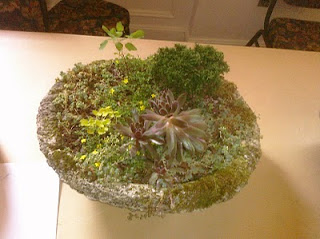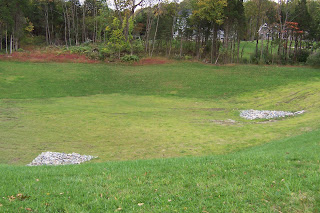Hypertufa Garden Troughs
 Dan and I spent Sunday at the Watnong Chapter of the North American Rock Garden Society meeting admiring club members' handsome hypertufa alpine troughs, viewing slides of troughs and alpine rock gardens, attending a workshop about creating an appropriate soil mix for the troughs, and learning about the giant alpine trough at the Haggerty Education Center at Frelinghuysen Arboretum. The presenter was Mike Wilson, who recently retired as the rock garden specialist there and now heads his own consulting design firm.
Dan and I spent Sunday at the Watnong Chapter of the North American Rock Garden Society meeting admiring club members' handsome hypertufa alpine troughs, viewing slides of troughs and alpine rock gardens, attending a workshop about creating an appropriate soil mix for the troughs, and learning about the giant alpine trough at the Haggerty Education Center at Frelinghuysen Arboretum. The presenter was Mike Wilson, who recently retired as the rock garden specialist there and now heads his own consulting design firm.Within the next few weeks, Dan will join our friend Diane and her neighbor to experiment with various recipes and forms for making the troughs. In August, the Garden Club of Central Sussex County will be holding a workshop for members and guests who want to learn "how to do it."
I feel as if there's a vortex of hypertufa swirling around me, but I'm not especially interested in it myself. Dan read me a bunch of "recipes" and described a variety of construction methods as I drove us to the meeting. One of the exhibitors explained how he scours out plant holes in feather rock, and Mike apologized that he forgot the sledgehammer that he had intended to use to split his tufa (limestone precipitate) rocks into container-sized pieces. He used a rock hammer and chisel instead. Sounds like too much work to me.
But I could hear Dan salivating at the idea of pummeling rocks into submission and needing specialized tools, such as the hard-to-find narrow-gauge trowel used for getting into the tight spaces between rocks. As you might expect, I was more fascinated by the unexpectedly long root systems of alpine plants, easily ten times the size of the above-ground portion of the plant, and the idea of a dwarf columbine that might grow in my garden.
I think that's why we make such a good team. I don't much care about the finer points of building arbors, rock walls, terraces, fences, or other structures; I just want them to get done so I can drape my plants in, on, over, and through them. Dan is all into building process and craft. Once he walks away from the construction, he appreciates the plants, but he doesn't really care what they are.
Find more information on the Watnong Chapter of the North American Rock Garden Society, at http://www.nargs.org/index.php?option=com_content&view=article&id=105:watnong-chapter&catid=36:chapter-stuff&Itemid=110
Photos: Courtesy of Dan Freed
Search Amazon.com for hypertufa


